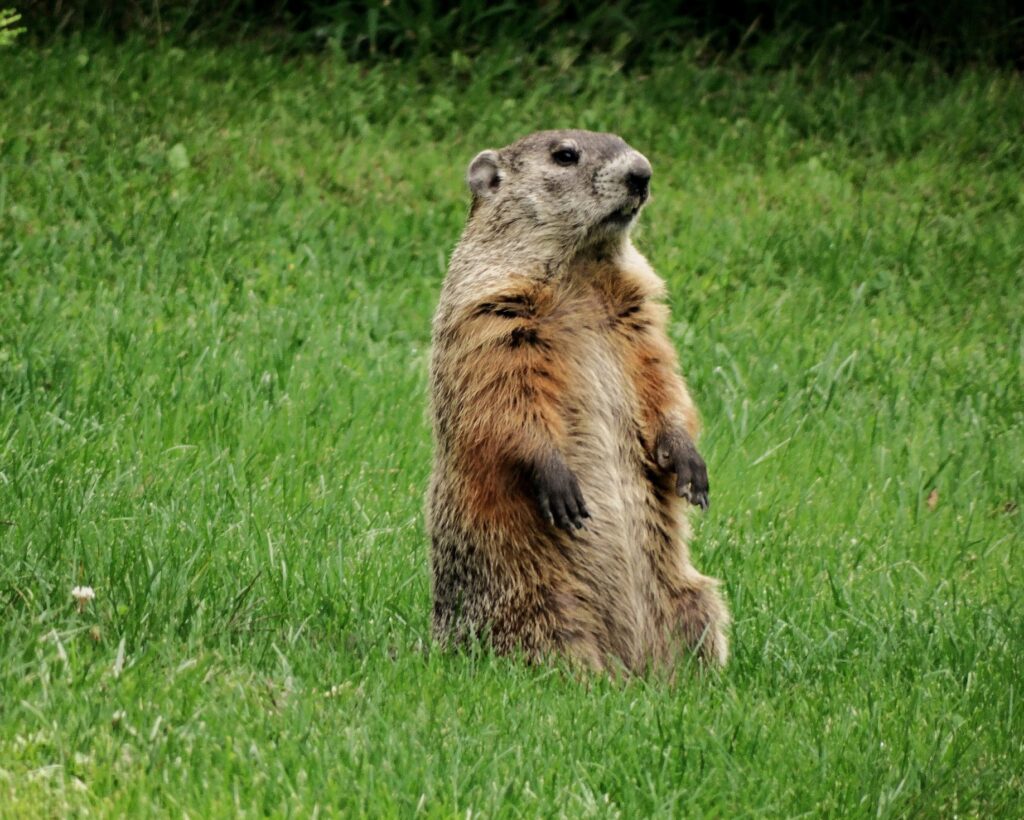Dear Dot,
How can I remove gophers from my yard? We are trying a live trap but they go past and are eating roots off all plants and even my huge collection of aloe vera. Please advise … no poisons obviously.
—MaryAnn Marquez
The Short Answer: Homeowners can often confuse gophers and groundhogs, says Toronto Wildlife Centre Executive Director. Her advice? Call your local wildlife center or humane society. They will be more familiar with what specific animals live in your vicinity and how to better address any unwanted behavior.
Dear MaryAnn,
Though I have no reason to doubt your gopher-spotting abilities, I must ask you the same question that I was asked when I reached out to a couple of experts on dealing with urban wildlife: Are you sure it’s a gopher?
Gophers and groundhogs, I’m told, are often mixed up. What’s more, while groundhogs, common in North America, prefer somewhat populated wooded areas (humans = food), gophers, a sort of groundhog-adjacent rodent, are partial to more grassy or sandy terrain in North and Central America.
Both belong to the Rodentia order. But groundhogs (also known as woodchucks, and I apologize because you and I both will have that tongue twisty poem locked in our brains for the rest of the day) are part of the Sciuridae family — think squirrels, prairie dogs, chipmunks. The gopher, on the other hand, is a member of the Geomyidae family, which includes various species of mice and rats. This also gives a hint as to size. Adult groundhogs are typically the size of a large housecat, about twice the size of gophers, and though groundhogs like to dig, they don’t burrow tunnels with the same glee as gophers.
If you’re still scratching your head about which interloper you’re dealing with, start by taking a look at the tail: gophers’ tails are hairless and thin, like a rat’s; groundhogs’ tails are thick and bushy. (Fun fact about those tails, MaryAnn: Gophers often walk backwards and so their smallish tails act as something of a white cane, feeling the ground behind them.) Groundhogs have the distinction of whiter, less visible teeth, while gophers look like they could stand a trip to both a dentist and an orthodontist. Oh, and gophers have little cheek pouches, where they store food. Groundhogs do not.


One point I would like to make before we dig into what the actual experts say: While there have been numerous groundhog sightings in Dot’s neighborhood, these animals have been rare in Dot’s yard. One brave (or perhaps dumb) soul visited Dot’s yard not long ago, and I was smitten — they are adorable. My two large dogs, however, saw this groundhog’s arrival as a declaration of war. Though I didn’t allow the dogs outside to defend their territory, I suspect evidence of their presence in our yard is a major deterrent. So … my non-expert, anecdote-based solution #1: Get thee a dog. Or two.
What does an actual expert have to say? Whichever critter you’re wrestling with, be it a gopher or a groundhog, Nathalie Karvonen, Executive Director with the Toronto Wildlife Centre, has some sound advice. (And don’t miss this great “My Green Job” profile about Andrew Wight on our Bluedot Toronto site — Andrew spends his days helping big-city folks deal with urban wildlife problems.)
If you were to call the Toronto Wildlife Hotline, Nathalie says, “we’d want to ask a lot more questions.” Such as? “What is the animal, obviously? Do they have a tunnel system in the area? What plants are they targeting? What is [your] garden like — is it a raised bed or open garden? And how do [you] actually know it’s these animals eating the roots of the vegetables, since the roots are presumably underground?”
Indeed, Nathalie suggests you do exactly that, MaryAnn — call a wildlife center or humane society in your region that will be more familiar with what specific animals live in your vicinity and how to better address any unwanted behavior.
No matter which annoying but perhaps adorable varmint is eating your vegetable roots, Nathalie offers some strongly worded cautions (both of which, I suspect, you will endorse wholeheartedly):
Number one, Nathalie says, “never use lethal methods to attempt to resolve a problem like this. If the area is a good one for the species — which it clearly is — and [the homeowner does] nothing to change the attractant, then more animals of this species will likely come along before long.” In other words, there are more where these guys came from!
And number two, “never block up holes without taking all the proper steps,” Nathalie says. “At this time of the year, for example, there could be tiny, helpless babies or animals still in torpor from the winter.” And let’s remember the fanfare that greets the rousing of slumbering groundhogs on February 2. These guys hibernate! Gophers don’t hibernate per se but are less active during colder seasons.
There’s plenty of online advice on how to fill gopher and/or groundhog holes, but step number one must be, ensure that the holes and tunnels are empty of critters when you do. The catch is it’s near impossible to know when they’re empty, as gophers, in particular, spend most of their time underground. What’s more, hole-filling might be an endless task, as burrowing animals that find one of their entrances blocked will just dig another one. Given that a live trap isn’t working for you (though most gopher experts cite it as their number one method), let’s take Nathalie’s advice to find ways to make your yard less appealing to these root-munchers.
Gophers have a strong sense of smell, a trait that we can harness for our benefit. How? Situate highly fragrant plants — eucalyptus, rosemary, lavender — around your more prized vegetation, creating a natural repellent. Soak cotton balls in essential oils, such as peppermint (which also works on mice), or castor oil (castor oil pellets work, too) and leave them at the entrances/exits of the burrows. Over subsequent days/evenings, move the scented deterrents further away as the animals retreat. Pet feces can work, too, and Dot’s happy to offer some up. My prodigious pups produce plenty. These smelly methods are harmless to the animals but likely to make them pack their bags and find less odoriferous accommodations.
Ultrasonic devices also have their fans. These devices emit a high pitch that we humans can’t hear but that is annoying to gophers, groundhogs, and other small burrowing animals. Though a better option, Dot believes, is to give in to nature’s circle of life and attract owls to your property by installing an owl house. Dot needn’t spell out why a watchful owl would make your yard less gopher- or groundhog-friendly.
Best of luck, MaryAnn. Whatever you do, do not think like a gopher. We know how that turned out.
Repellently,
Dot


